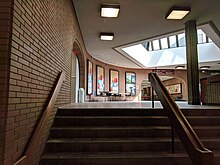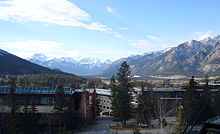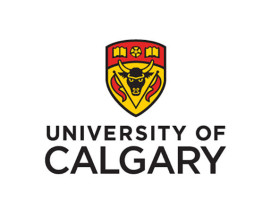tyle="color:#000000;">Alberta
, Canada. The University of Calgary started in 1944 as the Calgary branch of the University of Alberta, founded in 1908, prior to being instituted into a separate, autonomous university in 1966. It is composed of 14 faculties and over 85 research institutes and centers. The main campus is located in the northwest quadrant of the city near the Bow River and a smaller south campus is located in the city center. The main campus houses most of the research facilities and works with provincial and federal research and regulatory agencies, several of which are housed next to the campus such as the Geological Survey of Canada. The main campus covers approximately 200 hectares (490 acres).
A member of the U15, the University of Calgary is also one of Canada's top research universities (based on the number of Canada Research Chairs). The university has a sponsored research revenue of $380.4 million, with total revenues exceeding $1.2 billion. The university maintains close ties to the petroleum and geoscience industry through the Department of Geosciences and the Schulich School of Engineering. The university also maintains several other departments and faculties, including the Cumming School of Medicine, the Faculty of Arts, the School of Public Policy, the Faculty of Law, and the Haskayne School of Business.
Notable former students include Canadian Prime Minister Stephen Harper, Java computer language inventor James Gosling, Uber co-founder Garrett Camp, astronaut Robert Thirsk, and Lululemon Athletica founder Chip Wilson. The university has produced over 170,000 alumni who reside in 152 countries.
The University of Calgary was established in 1966, but its roots date back more than half a century earlier to the establishment of the Normal School in Calgary in 1905. The Alberta Normal School was established in Calgary to train primary and secondary school teachers in the new province. The Calgary Normal School was absorbed by the University of Alberta's Faculty of Education in 1945, and operated as a part of its Calgary branch campus, a satellite campus of the University of Alberta. Operating from the west wing of the Provincial Institute of Technology and Art, the Calgary University Committee was formed in 1946, in an effort to lobby for separate permanent facilities for the branch campus.
In July 1957, the University of Alberta signed a one-dollar lease with the City of Calgary, for 121.4 hectares (300 acres) of land. In 1958, the University of Alberta changed the name of the branch campus to the "University of Alberta in Calgary," and unveiled plans for new permanent facilities on the leased land. The new campus opened its first permanent facilities in October 1960, the Arts and Education Building (presently the Administration Building), and the Science and Engineering Building (presently Science A).
In May 1965, the satellite campus was granted academic and financial autonomy by the University of Alberta. In the following year, in April 1966, the institution was formally made into an independent university, with the passage of the Universities Act by the Legislative Assembly of Alberta. The university was modeled on the American state university (similar to the University of Alberta), with an emphasis on extension work and applied research. The governance was modeled on the provincial University of Toronto Act of 1906 which established a bicameral system of university government consisting of a senate (faculty), responsible for academic policy, and a board of governors (citizens) exercising exclusive control over financial policy and having formal authority in all other matters. The president, appointed by the board, was a link between the bodies to perform institutional leadership.
In the early 20th century, professional education expanded beyond theology, law, and medicine. Graduate training based on the German-inspired American model of specialized coursework and the completion of a research thesis was introduced. The university's first president, Herbert Stoker Armstrong, held a strong belief that "although the university is accountable to the society that supports it, the university must insist on playing a leadership role in intellectual matters if it is to be worthy of the name."
During the late 1960s, the University of Calgary's campus expanded dramatically with new buildings for engineering and science, the opening of the new University Theatre in Calgary Hall, and, in 1971, the launch of the program in architecture. In addition, the Banff Centre (originally known as The Banff School of Fine Arts) was affiliated with the University of Calgary in 1966.[14]

The Dutch speed skating team at the 1988 Winter Olympics. Olympic speed skating events were held at the university's Olympic Oval.
The University of Calgary played a central role in facilitating and hosting Canada's first winter Olympic games, the XV Olympic Winter Games in 1988.
21st century
In May 2001, the University of Calgary tartan was accredited in a ceremony presided over by the president of the Scottish Tartans Society and the director of the Register of All Publicly Known Tartans. The accreditation ceremony for the university's tartan was the first to take place in Canada. Use of the black, red, and gold tartan is limited to formal ceremonies, convocations, and a small number of items sold by the university. The tartan is also used by the university's pipe band.
On January 4, 2018, 21-year-old Connor Neurauter was sentenced to 90 days in jail and two years probation and had to register as a sex offender in Kamloops, B.C after obtaining and threatening to share photos of a minor under 16. It was then revealed that Neurauter would not serve his sentence until May 2018, in order to allow him to finish his semester at the University of Calgary. On January 6, the University of Calgary said that they were "reviewing the situation" and he had been advised to not be on campus the week of January 8. On January 9, a petition on change.org was started and as of January 12, had obtained over 65,000 signatures calling for the University of Calgary to expel him. The University of Calgary released a statement on January 11 stating they had no plans to expel Neurauter, but saying he had been advised to stay off campus for the remainder of the semester and that he would be escorted off campus if he appeared. The university received criticism for its decision to not expel Neurauter and its handling of the case in light of its new sexual assault policy. The decision to have Neurauter's sentence delayed in order for him to attend has also received criticism.
West Campus Development Project
In 2007, the University of Calgary, in partnership with the City of Calgary, began work on the West Campus Development Project through the West Campus Development Trust. As the lead developer for University District, the trust will oversee the development of the lands adjacent to the main campus, formerly known as the West Campus lands.
The primary goal of the trust is to manage the transformation of previously unused University lands, with the ultimate aim to generate a financial return on investment for the university's academic mission. Once completed, University District, situated between the university and Shaganappi Trail, will be a mixed-use, 200-acre community consisting of residential, office, retail, and park spaces. As of 2021, a number of condominium and commercial buildings had been completed, with commercial development anchored by a major grocery store.
MacKimmie Complex Redevelopment Project
The MacKimmie Complex and Professional Faculties Redevelopment Project is an ongoing multi-phase project to enhance the university's administrative and academic environments. The completed project will include the construction of new classrooms, centralized student services, student study space, and expanded academic research space. The new block also serves as the home for the Hunter Hub for Entrepreneurial Thinking.
Initial funding for project design and planning was announced in April 2016 by the Government of Alberta. On March 23, 2017, an additional amount of $262.8M was announced by the Government to be allocated over the next four years for the MacKimmie Complex and Professional Faculties Building Redevelopment.
Administration
The governance of the University of Calgary is conducted through a board of governors and a senate. The role of the board of governors and the senate is governed under the Post Secondary Learning Act, a provincial act of the Legislative Assembly of Alberta. The board of governors is responsible for the university's conduct, management, and control of the university and its property, revenues, business, and other affairs. Members of the board of governors include the chancellor of the university, the university president, two alumni nominated by the alumni association, a member of the university senate, nine members of the general public, as well as three students, and three staff members nominated by their respective associations.
The University Senate acts as an outreach body between the university and the wider community. The university's senate is made up of 62 members of the alumni association, academic staff, the student body, and the general public, as identified by the Post-Secondary Learning Act. Members of the senate include various members of the university community, including the university president, the chief academic officer of student affairs, academic staff, as well as one undergraduate and graduate student appointed by their respective student association. In addition to members of the university community, the senate also includes nine members of the general public, appointed by the Alberta Minister of Advanced Education. In relation to its mandate, the university senate is also the governing body that authorizes the issuance of honorary degrees.
The university senate is chaired by the university chancellor. In addition to chairing the senate, the chancellor also presides over all degree-conferring ceremonies and acts as the ambassador for the university.
The university's support staff are represented by the Alberta Union of Provincial Employees, organized as Local 052 University of Calgary chapter. In October 2008, the University of Calgary was named one of "Canada's Top 100 Employers" by Mediacorp Canada Inc. Later that month, the university was also named one of Alberta's Top Employers.
Academics

Science Theatres is home to the natural sciences, social sciences, and humanities.
The university offers 250 programs in post-secondary education awarding bachelor's, master's, and doctorate (Ph.D.) degrees. The University of Calgary has developed a wide range of undergraduate and graduate programs. The campus has an area of 200 hectares (490 acres) and hosts 14 faculties, 55 departments, and 85 research institutes and centers (see Canadian university scientific research organizations).
With the economic boom in Alberta in 2005, the government has promised $4.5 billion to post-secondary institutions in the province.
The university is accredited through Alberta's Post-Secondary Learning Act and is considered a "comprehensive academic and research university" (CARU). CARUs offer a range of academic and professional programs, which generally lead to undergraduate and graduate-level credentials, and have a strong research focus.
Faculties
The University of Calgary's faculties are:
Libraries and cultural resources

The Banff Centre for Arts and Creativity in Banff, Alberta has been associated with the University of Calgary since 1966.
Libraries and Cultural Resources (LCR) includes eight libraries, two art galleries, Archives, Special Collections, the University of Calgary Copyright Office, the Research Data Centre, and the University of Calgary Press.
MacKimmie library was the first library to open at the University of Calgary in 1966. Since then, five different library branches have been opened in order to provide students with a greater amount of literary choice in many subjects. In addition, the University of Calgary has the first library system in North America to contain a video game library. Over 3.7 million printed volumes combined with online access to more than 300,000 full-text electronic journals and more than 800 electronic databases are available at the university. As of 2012, the library system is the eighth largest, by the number of volumes held, in Canada. In 2011–2012 the university library was rated 43rd in North America for Total Library Expenditures by the Association of Research Libraries.
Branch libraries
The library system at the University of Calgary also has seven library branches:
- Taylor Family Digital Library – contains the greatest share of the library system's printed volumes, as well as rare special items like a gaming collection. In 2011 The Taylor Family Digital Library replaced the university's primary facility, the MacKimmie Library, which is no longer used as a library.
- Data Library
- Canadian Architectural Archives
- Fine Arts and Visual Resources
- High-Density Library – located at the university's Spy Hill Campus, serves as a climate-controlled repository for lesser-used materials, which may be called back for use as required.
- Business Library, including the Virtual Business Library
- Doucette Education Library
- Bennett Jones Law Library, including the Virtual Law Library
- Health Sciences Library
- Gallagher Library of Geology and Geophysics
- The Military Museums Library and Archives
Taylor Family Digital Library
The Taylor Family Digital Library (TFDL) is a convergence of libraries, historical archives, art museums, scholarly publishing, and student academic support services. The TFDL was officially launched on October 20, 2011. The TFDL allows the full re-engineering of the university's library system, creating more and better space for teaching and learning resources while moving the majority of the University of Calgary's growing collection off campus to a high-density library. In addition, The TFDL offers books and online resources, a large Learning Commons with a café, workrooms, film and audio rooms, editing and recording suites, multimedia labs, quiet study areas, and seminar and consultation space for academic growth.
Don and Ruth Taylor, longtime supporters of the University of Calgary, donated $25 million in December 2006 to help build the new digital library. In recognition of the gift, the board of governors of the university named the library the Taylor Family Digital Library (TFDL).
In addition, the gift will also be used to create the Taylor Quadrangle, a green space in the center of campus adjacent to the TFDL.
The Taylor Family Digital Library is home to the Nickle Galleries, formerly known as the Nickle Arts Museum, which features exhibits of contemporary art, as well as rugs, textiles, and numismatic items from its collections.
Taylor Institute for Teaching and Learning
In celebration of the university's 50th anniversary, the University of Calgary launched the Taylor Institute for Teaching and Learning (TITL), which was built on the site of the former Nickle Arts Museum.
The building was constructed as a two-story, 4,000 m2 environmentally sustainable building to accommodate the increasing needs of the university. It features advanced teaching technology tools, mock classrooms, a simulation center for teaching, public lecture space, and multipurpose facilities.
The TITL provides education and teaching workshops and events for teachers and students to attend and further refine their educational goals. The institute also confers several awards and grants, including the University of Calgary Teaching Award and the PURE Awards for undergraduate research.
Innovate Calgary

Entrance to Innovate Calgary, the University of Calgary's business incubator.
The University of Calgary announced in 2010 the creation of a dedicated university-based incubator to provide working space and laboratory access for university spin-offs. The resulting incubator, known as Innovate Calgary, is based out of the 170,000-square-foot Alastair Ross Technology Centre located within the innovation research park. The research park is adjacent to the primary main campus and is open to any university-linked entrepreneurs.
Opportunity Calgary Investment Fund (OCIF) donated over $8.5M to help provide programs and support for university-linked startups. In addition to providing startup programs and services, Innovate Calgary also operates as the tech transfer office for the university by providing Intellectual property (IP) support and services. Innovate Calgary has an informal partnership with Creative Destruction Lab (CDL) to identify and support regional startups with demonstrated potential.
Reputation





